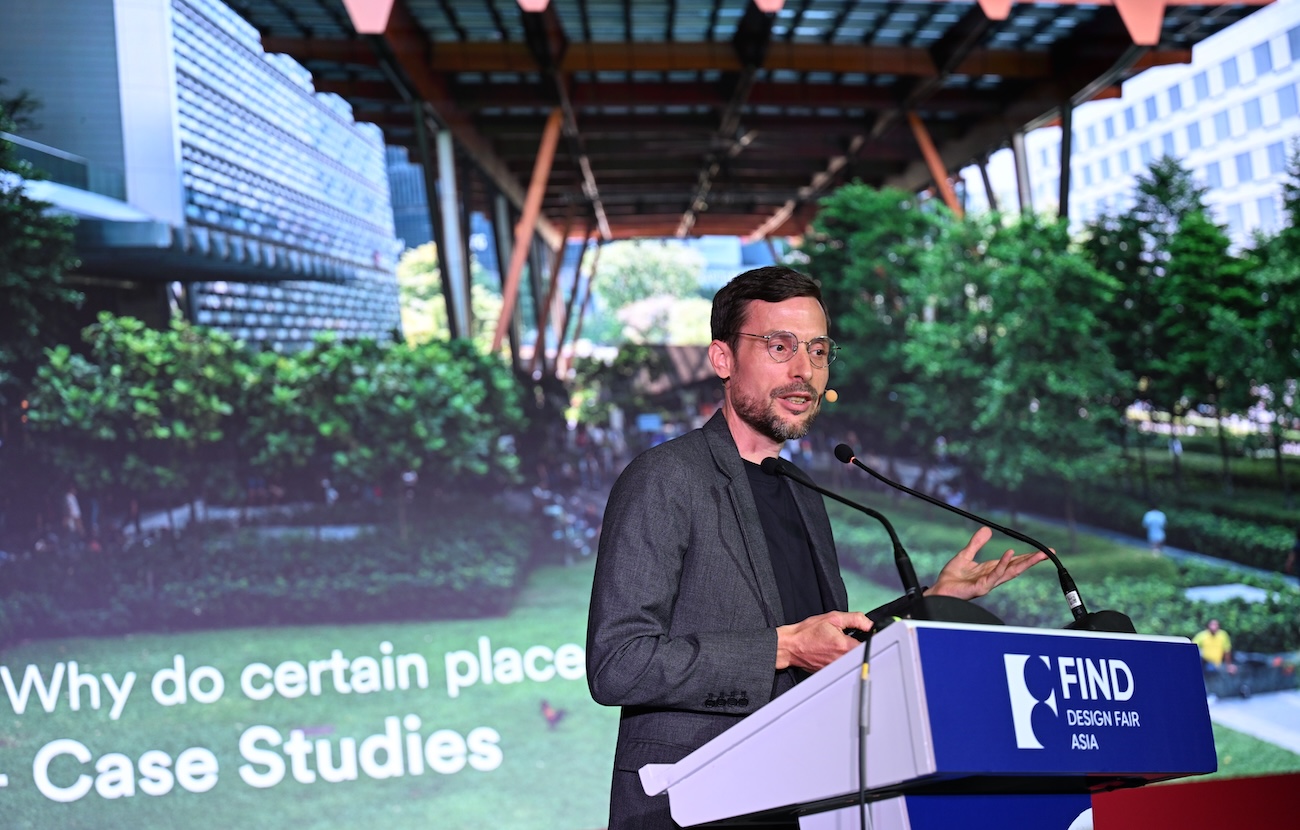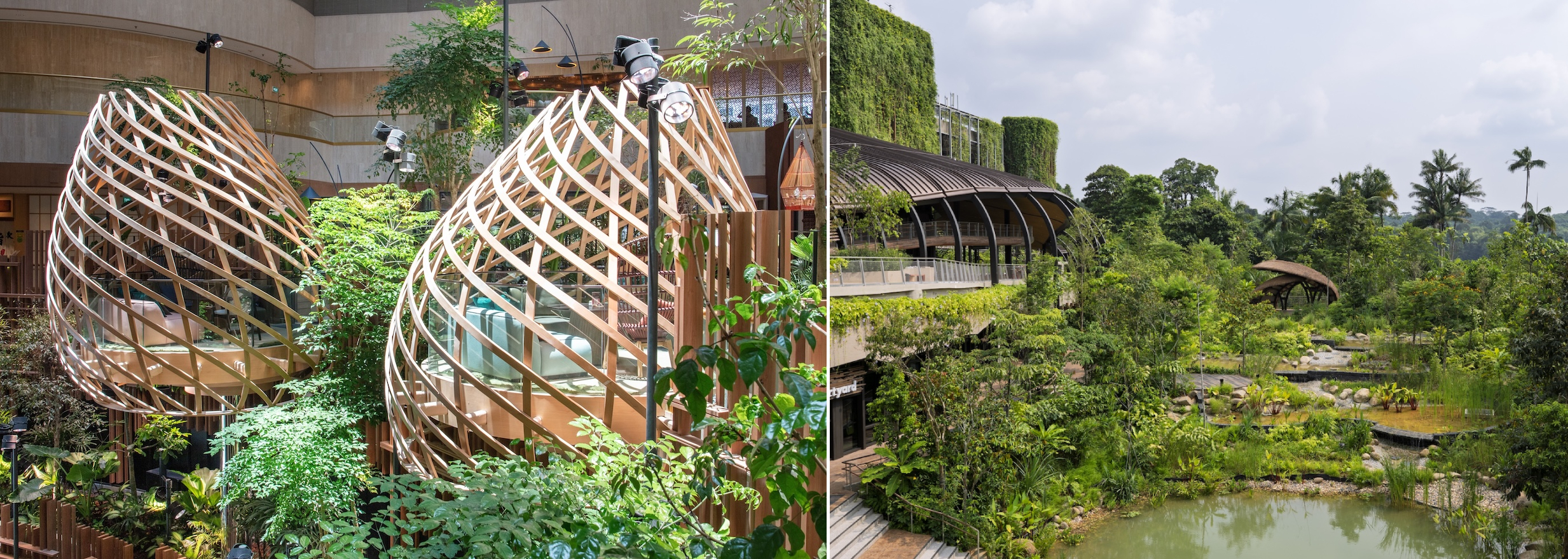
The PERSPECTIVE Interview
The compelling case for sustainable design
Highly regarded landscape architect Bernd Michael Schernau, photographed above speaking at Design Fair Asia, uses evidence-based research to show clients that sustainable design solutions are not only good for the planet and its inhabitants, but also for the corporate bottom line. Now based in Singapore, the global leader in Integrated Sustainable Design and Associate Director of Henning Larsen spoke to PERSPECTIVE about the critical relationship between the natural and built environments, especially in densely populated Asian cities, and the integration of cost-effective regenerative principles relating to the likes of water cycles, biodiversity, and circularity. As you’ll see from his answers below, Bernd’s strategies are always grounded in real-world use, low-maintenance design, and cultural relevance.
Question 1: Many of Asia’s cities have high density populations and living conditions. To what extent can architecture make a positive impact on the social pressures that exist in such an environment?
Bernd:
Well… people do choose to live in the city, so I guess they have to accept that it will be busy!
Jokes aside, architecture can make a real impact by creating sanctuaries – little oases – within dense urban environments. These spaces don’t remove the city’s energy, but they enhance the quality of life for everyone by offering moments of calm, connection with nature, and opportunities for social interaction. Thoughtful design can help balance the intensity of urban living, providing spaces where people can breathe, relax, and recharge, even in high-density conditions.

Tropical urban oases created by Henning Larsen. Left: Interior gardens at Parkroyal Marina Bay; Right: Cleansing biotopes at Mandai East.
Question 2: You are known for encompassing the environment into your work. Sometimes clients embrace sustainability but at other times there is a resistance, often dictated by economic factors. What can architecture do to embrace sustainability?
Bernd:
We often face clients who hesitate to make upfront investments in sustainable solutions, even when long-term savings are clear. To address this, we rely on evidence-based research. For example, energy-efficient systems or rainwater-harvesting strategies that can cut operational costs by significant percentages over a few years. Concrete numbers like these help translate sustainability into a business case.
We also emphasize that sustainable choices impact branding and reputation, which increasingly influences younger consumers and tenants who care about eco-conscious practices. Framing sustainability as both a financial and social asset makes it more compelling.
Another approach is prototyping at a small scale, such as Henning Larsen’s KlimaKover (see images below) which shows that innovative systems can work in real life. Seeing it in action makes the concept tangible and persuasive for clients.
Ultimately, it’s on us as designers to lead and demonstrate what’s possible. By combining data, visibility, and tangible examples, we can show that sustainability is not just aspirational, it’s practical, strategic, and transformative for both clients and society.
Question 3: How is technology changing your work as an architect? Is AI a threat that may replace talent or is it a tool that will assist our industry?
Bernd:
Well, to be honest, AI even helped me answer your questions today! [laughs]
I prefer to see it as a tool rather than a threat. At the moment, if we don’t use it, we risk falling behind. It allows us to work faster, explore more ideas, and test concepts efficiently.
In the long run, it’s hard to predict exactly where AI development will take us. I do notice cultural differences: in Europe, there’s more concern about intellectual property and potential misuse, whereas in Asia the focus tends to be on how to leverage AI for innovation and opportunity.
So for me, AI is a tool that can assist and amplify our creativity, but the real value still lies in how architects apply judgment, imagination, and experience—things a machine can’t replace.

A prototype of the KlimaKover shelter now on public display on Governors Island in New York. Developed by Henning Larsen in collaboration with the University of Pennsylvania and AIL Research, KlimaKover is a low-energy, modular system designed to cool public spaces using 10 times less power than conventional air conditioning.
Question 4: What advice would you give to a young person considering a career in landscape architecture?
Bernd:
Landscape architecture is a bit special compared to other disciplines. The margins may not be as high, so most people don’t enter it for financial reasons. Instead, they’re driven by a desire to do something good, something healing for our planet, or by a deep emotional connection to nature.
It’s a profession that is more about giving than exploiting. It demands a broad skill set: ecology, botany, geology, technical expertise, but also creativity and design thinking. At the heart of it lies placemaking, shaping environments where people feel connected, comfortable, and inspired.
Being a landscape architect means to never stop being curious: learning about flora and fauna, understanding ecological processes, but also keeping an eye on emerging trends and asking where we, as designers, can have the most positive impact.
So, my advice is: if you’re passionate about nature and people, and ready for lifelong learning, it’s one of the most rewarding paths you can choose.